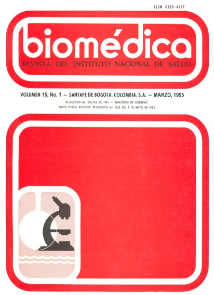Adenopatía leishmaniásica
Abstract
We report a 12 year old patient from the rural area of San Nicolás in Quipile (Cundinamarca) who presented a 8 x 5 cm left inguinal mass. A leishmania looking ulcer was found during the physical examination on the inferior part of the same leg. The skin biopsy got lost in the mail and the surgical resection of the inguinal mass showed lymph nodes with granulomas suggestive of sarcoidosis. The clinico-pathological and epidemiological correlation allowed us to diagnose and to treat this patient as cutaneous leishmaniasis; there was a prompt cure of his leg ulcer and the remaining inguinal mass. It was possible to demostrate, retrospectively, amastigotes when reviewing lymph node section and tissue embedded for electron microscopy . Using monoclonal antibodies anti-amastigotes of leishmania, it was possible to show a few phagocitosed parasites in macrophages of the lymph node granulomas. Leishmania adenopathy may be the initial reason to visit a phisician and it should be taken into account in the diagnosis of granulomatous inflamrnation of lymph nodes. By means of clinical, epidemiological, parasitological, histopathological and imrnunological criteria, it should be stablished if a given adenopathy is visceral or some other type of leishmaniasis.
Downloads
| Article metrics | |
|---|---|
| Abstract views | |
| Galley vies | |
| PDF Views | |
| HTML views | |
| Other views | |


























